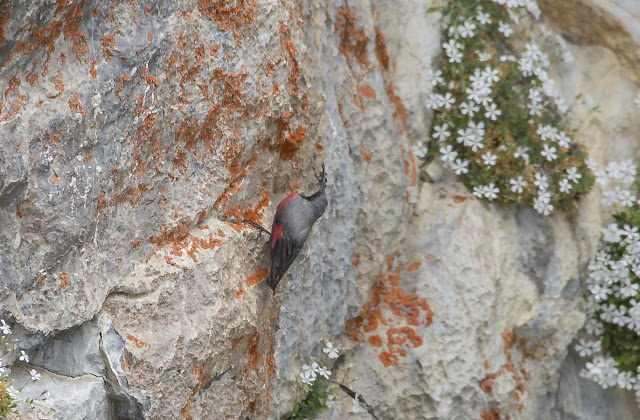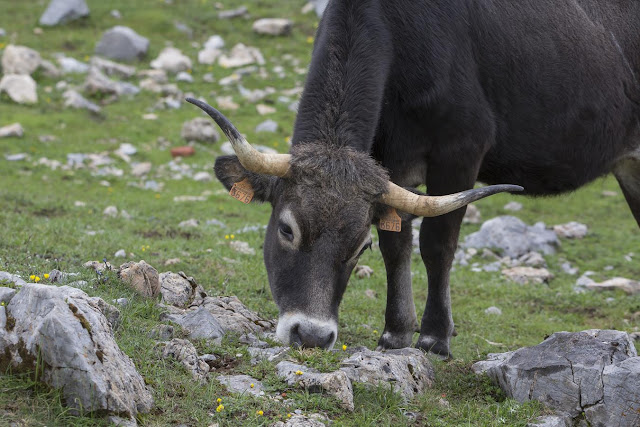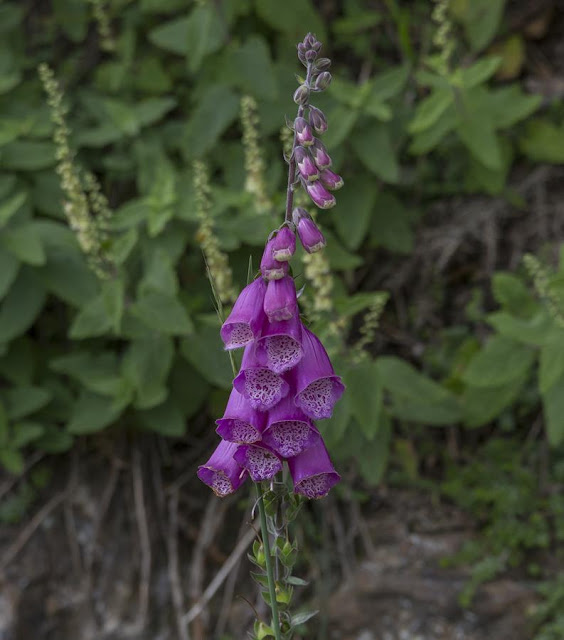In the following link you can see our national and foreign trips planned for this year.
Hola de nuevo.
Hello again.
Hello again.
Esta vez os muestro lo que pudimos ver uno de nuestros viajes de tres días al Parque Nacional de Picos de Europa a finales del mes de julio.
This time I show you what we could watched on one of our three-day trips to the Picos de Europa National Park at the end of July.
El objetivo de este viaje era poder ver, y en su caso fotografiar, aves alpinas con especial predilección por los treparriscos (Tichodroma muraria) y los gorriones alpinos (Montifringilla nivalis).
Target of this trip was to watch, and if possible photograph, Alpine Birds with a special predilection for Wallcreepers and Snowfinches.
El tiempo durante los tres días fue regular pues en todos tuvimos niebla y algo de lluvia.
Weather during the three days was not very good because in all we had fog and some rain.
Primer día:
First day:
Después de acomodarnos en el hotel salimos a nuestra primera excursión a ver lo que podíamos ver aunque tuvimos que esperar un rato en la cafetería hasta que la lluvia remitió un poco. En la foto un macho de pardillo común (Carduelis cannabina).
After settling in the hotel we went to our first excursion to see what we could watch although we had to wait a while in the cafeteria until the rain subsided a bit. In the photo a male of Common Linnet.
Bisbita alpino (Anthus spinoletta).
Water Pipit.
Joven de collalba gris (Oenanthe oenanthe).
Juvenile of Northern Wheatear.
Vimos un rebaño de rebeco cantábrico (Rupicapra pyrenaica parva).
We saw a herd of Cantabrian Chamois.
Joven.
Juvenile.
Con gran excitación pudimos contemplar nuestro primer treparriscos (Tichodroma muraria) del viaje.
With great excitement we could watch our first Wallcreeper of the trip.
Y también algunos gorriones alpinos (Montifringilla nivalis). En la foto un joven.
And also some Snowfinches. In the photo a juvenile.
Que pena que estuviese tan cerrado en niebla.
What a pity it was so foggy.
Segundo día:
Second day:
A primera hora hacia un día estupendo y pudimos disfrutar de unas impresionantes vistas del Macizo Central. En la foto una hembra de pardillo común (Carduelis cannabina).
The weather at frist morning ours was sunny so we could enjoy with the stunning views of the Central Massif. In the photo a female of Common Linnet.
Joven de Gorrión alpino (Montifringilla nivalis). Sin la niebla parecen otras aves distintas a las que habíamos visto el día anterior.
Juvenile of Snowfinch. Without fog they look like other different Birds than we had seen the day before.
A mi me gustan más los jóvenes que los adultos. Estos últimos tiene cara de pocos amigos.
I like juvenile more than adult. The latter has like an angry face.
Adulto.
Adult.
Un poco después vimos un grupo de acentores alpinos (Prunella collaris).
Some time later we saw a flock of Alpine Accentor.
Bonitas aves.
Beautiful Birds.
Como ya no hacía sol vimos pocas mariposas. En la foto una ortiguera (Aglais urticae).
As it was no longer sunny we saw few butterflies. In the photo a Small Tortoiseshell.
Y esta otra creo que se trata de una erebia oscura de Esper (Erebia pronoe).
And I think this one is a Water Ringlet.
Avión roquero (Ptyonoprogne rupestris).
Crag Martin.
Esta pareja de treparriscos (Tichodroma muraria) nos hicieron pasar una mañana inolvidable. El macho es el de la izquierda.
This pair of Wallcreeper made us spend an unforgettable morning. The male is the one on the left.
Macho.
Male.
Pude observar que el macho llevaba más veces comida a sus polluelos que la hembra.
I could see that the male took more food to his chicks than the female.
La hembra.
The female.
También me di cuenta que ella llevaba más arañas que el macho.
I also noticed that she carried more spiders than the male.
Que bonitos son.
How beautiful they are.
Otra vez el macho.
Again the male.

La hembra.
The female.
Daba gusto oír cantar al macho.
It was great to hear the male sing.
La verdad es que pasamos mucho tiempo contemplándolos. La hembra.
The truth is that we spent a lot of time watching them. The female.
Vimos algunos más pero decidimos continuar con otras aves pues ya los habíamos visto a placer.
We saw some more but we decided to continue with other Birds because we had seen them at pleasure.
Además de las aves que se pueden observar en el Parque, las vistas son espectaculares. Es un sitio realmente precioso.
In addition to the Birds that can be seen in the Park views are also spectacular. It is a really beautiful place.
Macho de colirrojo tizón (Phoenicurus ochruros).
Male of Black Redstart.
Es una pasada ver lo confiadas que son las chovas piquigualdas (Pyrrhocorax graculus).
It is amazing to see how tame the Yellow-billed Chough are.
Muchas de ellas están anilladas.
Many of them are ringed.
También hay muchas plantas y flores muy bonitas. En la foto un áster alpino (Aster alpinus).
There are also many beautiful plants and flowers. In the photo an Alpine Aster.
Cardo azul (Eryngium bourgatii).
Mediterranean Sea Holly.
Rampion de cabeza redonda (Phyteuma orbiculare).
Round-headed Rampion.
Esta es una de las que más me gustan las gencianas (Gentiana acaulis).
Stemless Gentian.
Y el resto no se como se llaman. Bienvenido será el que me lo diga.
And the rest I do not know what they are called. Welcome will be the one to tell me.
Siempre se ven algunos ejemplares de esta vaca que es de raza tudanca autóctona de Cantabria.
You always see some specimens of this cow that is native of Cantabria the Tudanca breed.
Bisbita alpino (Anthus spinoletta).
Water Pipit.
Vimos tan solo un quebrantahuesos (Gypaetus barbatus) aunque estaba tan lejos que no pudimos determinar cual de los ejemplares reintroducidos era. En la foto se ve que lleva un marcaje alar de color amarillo y radiotransmisor.
We saw only one Lammergeier although it was so far away that we could not see which of the reintroduced specimens it was. In the photo you can see that it has a yellow winged mark and radio transmitter.
Más chovas piquigualdas (Pyrrhocorax graculus).
Some more Yellow-billed Chough.
Alimoche común (Neophron percnopterus).
Egyptian Vulture.
Gorrión alpino (Montifringilla nivalis).
Snowfinch.
Rebeco cantábrico ((Rupicapra pyrenaica parva).
Cantabrian Chamois.
Macho de collalba gris (Oenanthe oenanthe).
Male of Northern Wheatear.
Tercer día:
Third day:
Al igual que el día anterior amaneció un día estupendo. Peña Vieja al fondo.
Just like the day before, a great day dawned. Peña Vieja in the background.
Antes de descender hasta la franja del bosque para ver otras especies de aves, decidimos dar un pequeño paseo por la pradera alpina.
Before descending to the timber line to watcha species of Birds, we decided to take a short walk on the Alpine-steppe.
Colirrojo tizón (Phoenicurus ochruros).
Black Redstart.
Bisbita alpino (Anthus spinoletta).
Water Pipit.
A este no le molestaba mucho el no tener una pata para reproducirse.
It did not bother to it not to have a leg for breeding.
Joven.
Juvenile.
Macho de pardillo común (Carduelis cannabina).
Male of Common Linnet.
Macho de collalba gris (Oenanthe oenanthe).
Male of Northern Wheatear.
Joven.
Juvnile.
Los helechos abundaban en las umbrías.
Ferns abounded in shady areas.
Campanilla silvestre (Campanula persicifolia).
Peach-leaved Bellflower.
Cuando llegamos a la zona limítrofe con el bosque las nubes ya se habían instalado. En la foto una águila calzada (Aquila pennata) fase clara que estaba siendo hostigada por un cernícalo vulgar (Falco tinnunculus).
When we reached the area bordering the forest, the clouds had already settled. In the photo a Booted Eagle pale phase that was being harassed by a Common Kestrel.
Chova piquirroja (Pyrrhocorax pyrrhocorax).
Red-billed Chough.
Rebeco cantábrico ((Rupicapra pyrenaica parva).
Cantabrian Chamois.
Acentor común (Prunella modularis).
Dunnock.
Milano negro (Milvus migrans).
Black Kite.
Macho de tarabilla europea (Saxicola rubicola).
Male of Common Stonechat.
Y al que íbamos buscando no tardó en aparecer, el escribano cerillo (Emberiza citrinella). Todos los que vimos, que fueron muchos, eran machos.
And the one we were looking for did not take long to appear, the Yellowhammer. All we saw, which were many, were males.
Preciosa ave.
Beautiful Bird.

Macho de pardillo común (Carduelis cannabina).
Male of Common Linnet.
Hembra.
Female.
En nuestro recorrido encontramos varios territorios del escribano cerillo (Emberiza citrinella).
In our track we found several territories of Yellowhammer.
Bisbita arbóreo (Anthus trivialis).
Tree Pipit.
Había gran cantidad de flores y plantas en los parados de alta montaña. En la foto unas calzas de lobo (Digitalis parviflora).
There were a lot of flowers and plants in the high mountain fields. In the photo a Small-Flowered Foxglove.
Dedalera común (Digitalis purpurea).
Common Foxglove.
Genciana amarilla (Gentiana lutea).
Great Yellow Gentian.
Lirio azul (Iris latifolia).
English Iris.
Como na hacía sol y la temperatura era fresca vimos pocas mariposas. En la foto una niobe (Argynnis niobe).
Niobe Fritillary.
Doncella ibérica (Melitaea deione).
Provençal fritillary.
Blanquita de la col (Pieris rapae).
Small White.
Colias de Berger (Colias alfacariensis).
Berger's Clouded Yellow.
Abejorro común (Bombus terrestris).
Buff-tailed Bumblebee.
Cuervo grande (Corvus corax).
Common Raven.
Otro precioso macho de escribano cerillo (Emberiza citrinella).
Another beautiful male of Yellowhammer.
Zorro común (Vulpes vulpes).
Red Fox.
Culebrera europea (Circaetus gallicus).
Short-toed Eagle.
Buitre leonado (Gyps fulvus).
Griffon Vulture.
Y el último de los escribanos cerillos que vimos (Emberiza citrinella).
And the last Yellowhammer seen.
También hicimos otra parada un poco más abajo para ver si veíamos algún alcaudón dorsirrojo (Lanius collurio) y no nos defraudaros. En la foto un macho adulto con dos de sus jóvenes.
We also made another stop at a little lower altitude to see if we were able to spot some red-backed shrike and they were there. In the photo an adult male with two of his juveniles.
El macho.
The male.
Uno de los jóvenes.
Juvenile.
Y en trayecto de regreso a Madrid vimos varios alimoches comunes (Neophron percnopterus).
And on the way back to Madrid we saw several Egyptian vultures.
Espero que os haya gustado. Hasta pronto.
I hope you liked it. See you soon.


























































































































































No hay comentarios:
Publicar un comentario